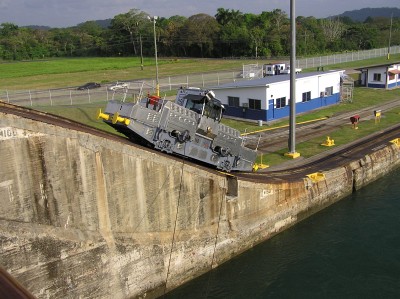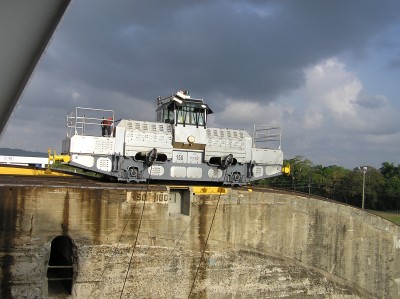 |
We were due to take on the Canal pilot at 6:22am, but I missed that.
However, by 7am every outside deck rail was crowded with passengers
watching the operations. |
 |
We docked at the long mole between the two sets of locks at
Gatun. Looking ahead we could see the flight of locks that would
take us up to Gatun Lake. |
 |
In the early days of the canal, ships were not allowed to move
under their own power. Instead, they were towed by locomotives known
as "mules". Nowadays, some ships may use their own propulsion
systems to move, but the mules remain, acting to keep the ships
centred in the lock chambers and particularly when going through the
gates. Here there are two mules for the port-side bow lines. The
front mule can tow the ship forward, while the second one can act as
a brake and assist in halting the ship. |
 |
Looking back, the stern lines have not yet been attached. |
 |
A close-up of a mule and its operator. The gong, or bell,
mounted on the side is used to acknowledge receipt and understanding
of instructions received. |
 |
There is a freighter in the left-hand flight of locks. It is a
bit ahead of us: it will move into the next chamber while our basin
is filling. |
 |
The freighter is almost into the next chamber. On the starboard
side it has only one mule at the stern, to keep it centred and to
act as emergency brake should it run forward towards the upper lock
gates. |
|

 To
our right, the mule at our stern climbs up to the next level as we
move into the next chamber. To
our right, the mule at our stern climbs up to the next level as we
move into the next chamber.
|
|

 It
gets to the next level, we are already in the next chamber, the
gates close, and our chamber starts filling. It
gets to the next level, we are already in the next chamber, the
gates close, and our chamber starts filling.
|
 |
Behind the freighter, the Holland-America MS Zuiderdam comes to
the dock, aided by tug boats, to have its towing lines hooked up to
its mules. |
 |
Our ship is rising up, and the Zuiderdam is docked: all the
outside decks are packed with sightseers. |
 |
We are moving into the third (highest) chamber, the Zuiderdam is
advancing into the first chamber on the adjacent flight of locks,
and behind us another ship is approaching the locks. |
 |
When the lock gates close, handrails rise up so that workers can
cross from one side of the lock to the other. |
 |
We are moving out into Gatun Lake, and the lock gates close
behind us, so that the chamber can be emptied ready for the ship
that came up behind us. |